Eggs in treasure bags (Tamago no takarabukuro)
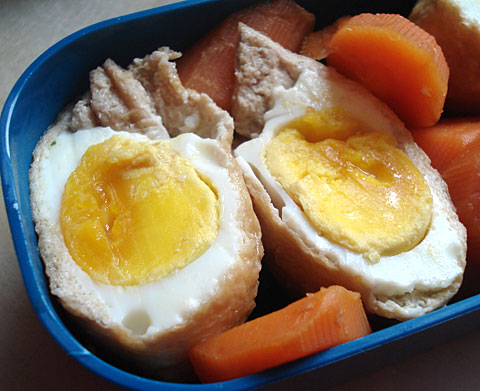
Takarabukuro (宝袋) is a treasure bag. In food terms, it's a small parcel that is cooked in a fried tofu skin (aburaage 油揚げ)bag - the one that's used for _inarizushi_. Here an egg is dropped gently into the bag, and then poached - so, an egg in a treasure bag! It is delicious hot or cold, and is very nice in a bento box as a main or secondary protein.
Rather than starting with a whole aburaage, I cheated a bit and used a pre-cooked inarizushi bag. (Here is how to cook your own inarizushi bags or skins.) I do usually have some aburaage in the freezer these days, but when I first came to live in Switzerland I found them very hard to find. On the other hand I could find canned or vacuum packed inarizushi skins even at generic gourmet food shops! I am guessing this is because aburaage has to be kept frozen or used right away, while cans and vacuum packs are easier to stock. In any case I've given instructions for using the premade inarizushi skins as well as uncooked aburaage.
Recipe: Eggs in treasure bags
- For each egg, you will need 1/2 of an uncooked aburaage or 1 precut inarizushi skin.
- You'll also need a strip of green onion, or a parsley or mitsuba stalk that has been blanched in hot water to make it limp and pliable. I used a thin green onion here.
For the poaching liquid, which can cook 4-6 egg-bags at a time:
- 2 cups of dashi stock (traditional or vegan, or 1 tsp. of dashi granules per cup of water)
- 1-2 Tbs. mirin (less if you are using inarizushi skins, more if you are starting with uncooked aburaage)
- 2-3 Tbs. soy sauce (less if you are using inarizushi skins, more if you are starting with uncooked aburaage)
- 1 medium carrot (optional) or other hard vegetables
Peel the carrot and cut up. Bring the poaching liquid ingredients together in a pan and bring up to a simmer.
If you are using aburaage, pour boiling water over them and leave until cool enough to handle. Drain well, roll over with a round chopstick to loosen them up, cut in half and carefully separate open up into a bag. Or, cook a batch of inarizushi skins, and use some for these eggs and keep the rest for inarizushi later!
If you are starting with inarizushi skins, that work has been done for you! This is the one I started with.
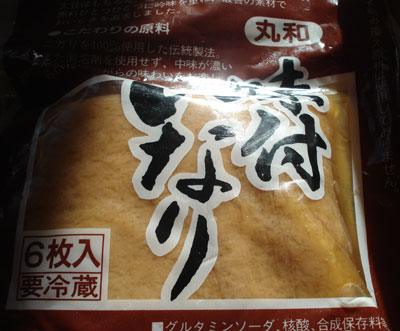
Open up one inarizushi skin bag or aburaage bag, and stand it up in a small cup. Break an egg and carefully slip the contents into the bag.
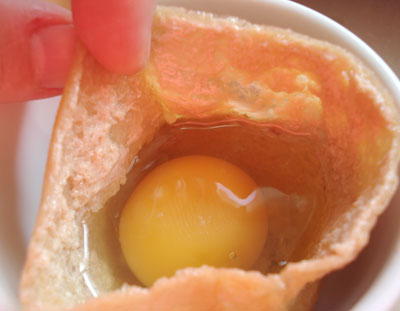
This is the most fiddly part. Tie the open mouth of the bag shut with the green onion strip or the parsley stalk. You can also skewer it shut with a cocktail stick. You don't have to worry about making it airtight, just closed enough so the egg doesn't float out.
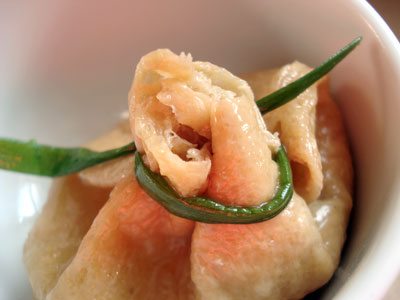
Put the bags carefully in the simmering water - lower the heat if it's bubbling too hard. Poach for 10-15 minutes until the bags feel a bit firm if you poke them lightly, and the carrots are cooked. (You can put daikon radish, or turnips, or potatoes, or any long-cooking hard vegetable in here and cook them with the bags.)
When the bags are cooked, they'll look like this.
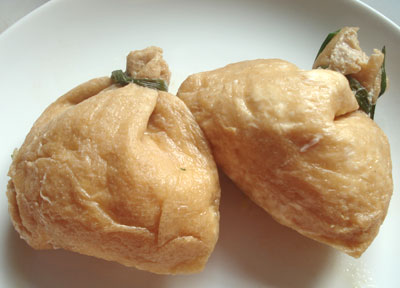
You can cook them in advance and store them in the refrigerator in the poaching liquid. They'll keep for a couple of days. You can put them in your bento as whole bags, or cut in half to reveal the egg inside.
The egg will have absorbed a lot of flavor from the poaching liquid, but if you find it too bland you can pack a small bottle of soy sauce to drizzle on it.
If you enjoyed this article, please consider supporting this site by becoming my patron via Patreon.
